Chapati, also known as chapathi, chapatti or Indian flatbread is a healthy and staple food all across India. It is as popular as malabar paratha, tandoori roti or naan. Chapati is made by combining wheat flour, salt, oil or ghee and water. Making soft chapati can be tricky, But I have shared all my tips and tricks to get soft chapati all the time. In this recipe for chapati, I have shared basic chapati recipe, method of making chapati dough in stand mixer, tips and hack for soft chapati and trouble shooting with step by step pictures and video.
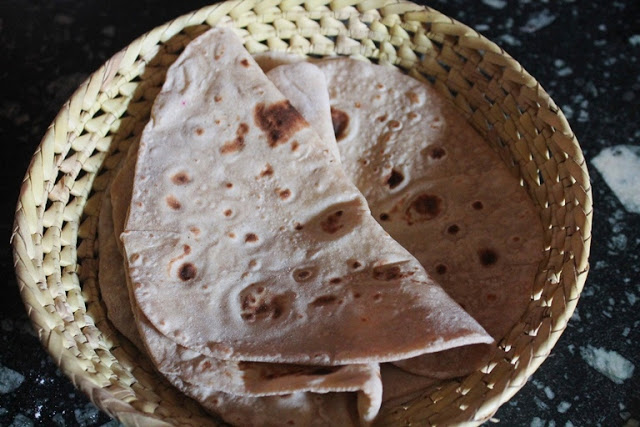
Chapati (Indian Flatbread)
Chapati is one of the staple food all around India. In our house we make it at least twice a week. We serve it with potato kurma, peas kurma or chicken gravy. Getting soft chapati needs some practice and experience. The more you make chapati and roll, you will get expert at it. Some of you have been asking me a to share tips and techniques to make soft chapati. In this blog post, I am sharing all my knowledge in chapati making.
Table of Contents
About Chapati (Indian Flatbread)
Chapati also known as chapatti, chappati, chapathi, or chappathi. It is also called as roti, rotli, safati, shabaati, phulka an unleavened flatbread originating from the Indian subcontinent and staple in India, Nepal, Bangladesh, Pakistan, Sri Lanka.
Chapatis are made with whole-wheat flour known as atta, mixed into dough with water, oil and optional salt in a mixing utensil called a parat, and are cooked on a tava (flat skillet). Some people use all purpose flour (maida) for making maida chapati or flour roti, but the traditional recipe used whole wheat flour (atta).
Soft Dough is made by mixing wheat flour, salt, water and oil. Rest the dough, divide into portions and roll each portion into chapati. Roti or chapati is cooked in hot tava and served with favorite curries. Depending on the flour we use, the water quantity will vary.
Difference between Chapati and Roti
While the ingredients used to make chapati and roti remains same. Both chapati and roti are slightly different because of their cooking technique.
Roti can be made with wheat flour or refined flour. Usually it is cooked in a tandoor or direct flame like making phulka. Roti has no fat added in them while chapati is cooked in a tawa with added oil or ghee. This can be made with variety of flours like corn (maize) and gram flour.
But many people used to call chapati as roti and vice versa. Some of the popular rotis are this Tandoori roti, Makki ki roti, Rumali Roti.
Similar Recipes
Masala Chapathi
Coriander Chapathi
Radish Paratha
Romali Roti
Phulka
Watch Chapati Recipe Video

Chapati Ingredients
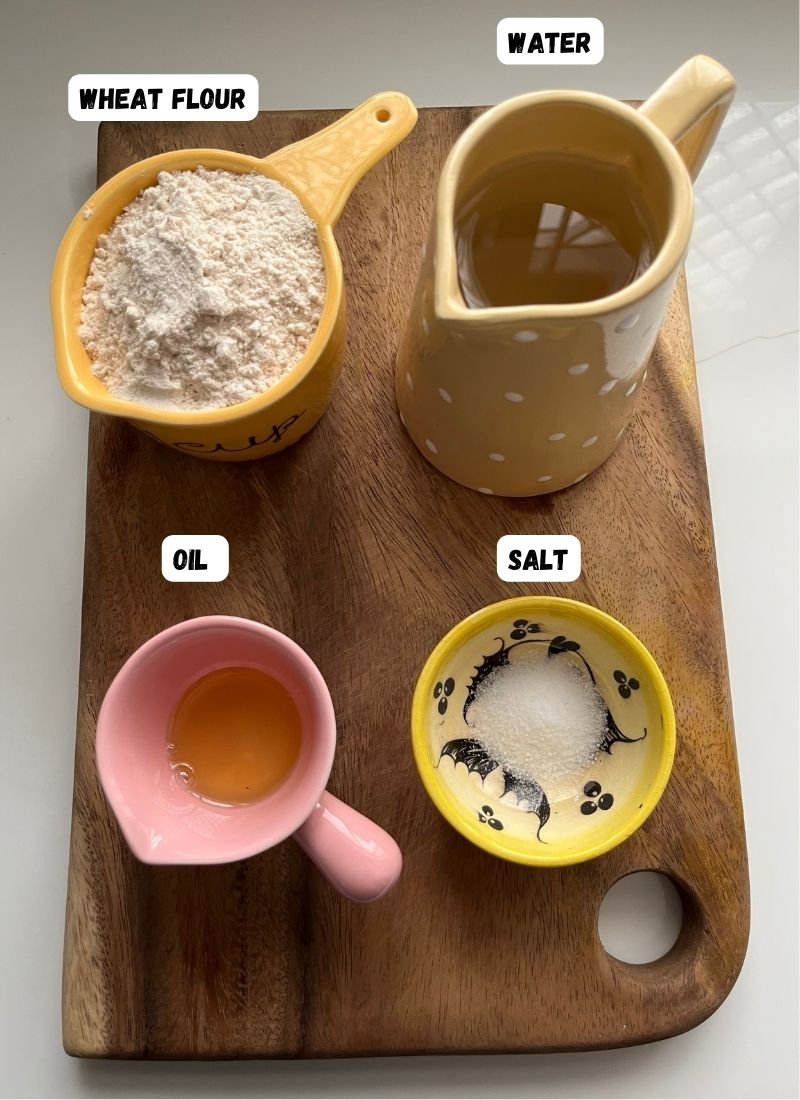
Wheat Flour - You can use any atta (wheat flour) to make chapati. Chakki atta, milled wheat flour, wholemeal flour, store bought atta or multigrain atta can be used. Depending on the brand of wheat flour you use, the required quantity of water will vary.
Salt - Salt enhances the taste of the chapati. You can add more or less depending on your preference. Some people avoid salt in their chapati which is fine too.
Oil or Ghee - a small amount of oil or ghee is added when making chapati dough. Once flatbread is cooked, drizzle with some ghee to make it soft.
Water - using warm water when kneading dough makes it soft.
Optional - some optional ingredients is added in chapati dough to make it extra soft which I have shared in my hacks section. Mashed banana, yogurt or curd, milk is used for making soft chapati dough. You can use spices, chopped herbs, onions, vegetables, fruits in dough.
Types of Wheat Berries (Godhumai)

Samba Wheat | Samba Godhumai
Samba wheat is richer in fibre than ordinary wheat as it is not polished and does not lose any of its nutrients during the process. It is usually used to make godhumai rava | dalia. For making homemade wheat flour, you can use a combination of samba wheat and punjab wheat. if you make wheat flour using only samba wheat which will affect the texture of chapati.
Punjab Wheat Berries | Punjab Godhumai
Whole wheat berries or punjab variety is good for making wheat flour. It is polished and gives you best texture roti when ground.
My Recipe for Homemade Wheat Flour (Atta)

Making wheat flour at home is easy and more nutritious. You can make atta at home easily. But it is essential that you give wheat to the mill for grinding. You cannot grind wheat at home. I have a proportion of making wheat flour at home which works great. You can give punjab wheat to mill for grinding. But a combination of samba wheat and punjab wheat makes wholesome atta.
Ingredients for Homemade Wheat Flour
- 3 Kg Punjab Wheat
- 1.5 Kg Samba Wheat
How to Make Homemade Wheat Flour
Wash wheat berries really well. Dry it under sun by spreading in a plate or a cloth for at least 2 to 3 days till it is completely dry. Give the dried wheat berries to mill and make it into a fine powder. Once it comes from mill, spread it on a clean cloth to cool off the wheat flour. Store in an air tight container.
Which wheat flour is Best for Chapati

Mill Wheat Flour
It is most commonly used wheat flour. The process of grinding wheat involves blending, grinding, sifting, and blending again, a variety of wheat. It has less bran intact and great for making parathas, naan, etc. It is much lighter and easy to digest.
Fresh Chakki Atta
Some of the healthy chapati is made using chakki atta. Chakki is an age old method of making Atta from whole grain wheat. Chakki is made of stone and it operates by turning the handle. Wheat is added to the moving stone wheels which then grinds and make flour. This flour is more nutritious because it still has the bran intact so it is rich in fibre and makes chapati wholesome. We can get them in local stores or even in super market these days.
Multigrain Atta
It is one of the best choice of atta for making chapati. Multigrain atta has different grains like oats, barley, millet, corn and chickpeas is combined with wheat to make a nutritious flour. Since it has variety of grains added, it is more wholesome and can be heavy sometimes.
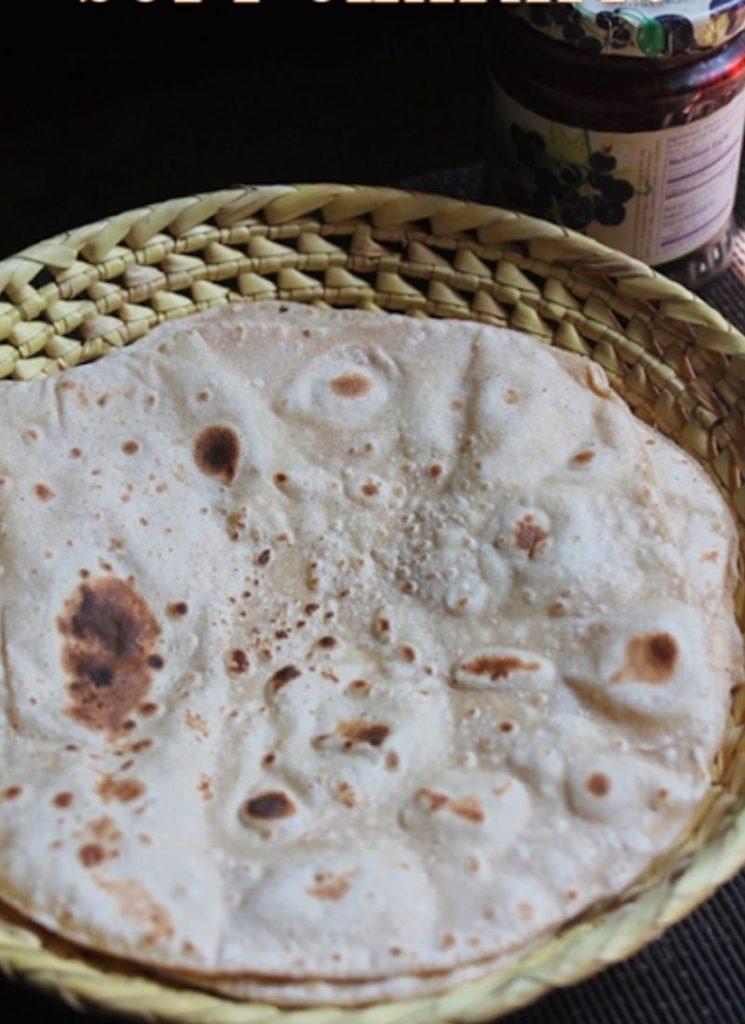
Tried & Tested Tips for Soft Chapati
Wheat Flour - try and source the best quality wholemeal flour. I prefer to use chakki atta which you can buy in super market these days. Quality and brand of wheat totally makes a difference.
Quantity of Water - Different brands of wheat flour requires different quantity of water. So experiment with your wheat brand. You have to make the dough soft without any cracks or dryness. Using warm water helps making soft chapati.
Adding Flour to Water and not vice versa - This is one secret, if you add wheat flour to water instead of water to flour makes soft chapati dough which results in soft chapati.
Kneading & Resting the Dough - Knead the dough for at least 2 to 5 minutes till the dough is soft and supple. Make sure you rest the dough at least 30 minutes. The longer you rest the softer flatbread you get. Cover the dough with damp cloth for moisture retention.
Cooking chapati - Cook chapati in a hard anodised pan which can retain heat. Don't keep on flipping the chapati, just two to three flips is enough. If you keep on flipping back and forth then the roti will turn hard and crispy.
Apply ghee once chapati is cooked - I don't use oil or ghee when the flatbread is cooking in the pan. Once I remove the cooked chapati on a plate, I drizzle with some ghee to make it soft.
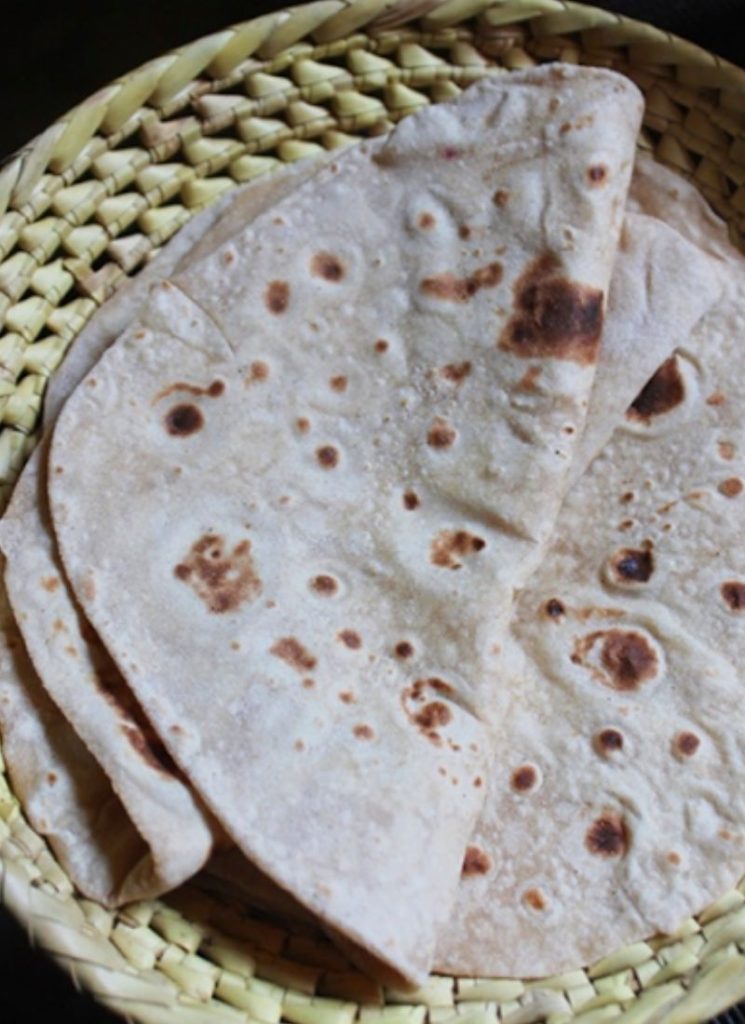
Parat (Traditional Chapati Dough Kneading Vessel)
For making chapati dough, You can use a wide plate with high edges. We call it Tambalam in Tamil, Parat in Hindi. This wide plate makes the kneading process easier.
Parat is a large flat plate used to mix the ingredients for making chapati mostly in India. The plate used is mostly made of brass or steel.

How to Make Chapati (Stepwise Pictures)
Making Chapati Dough
You can use a large mixing bowl like this one. Take water in this. You can use warm water or regular water.
Pro Tip: warm water makes the chapati more softer. But make sure the water is warm and not hot.
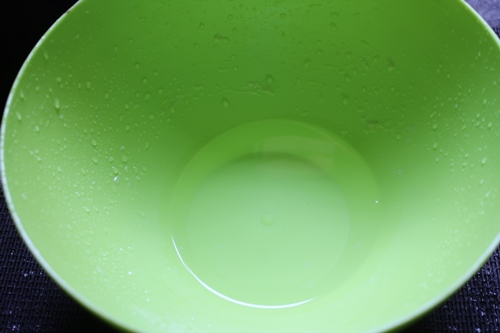
2)Add salt into the water. Mix the salt into the water so it dissolves before we add in the flour.
Pro Tip: Salt is optional, some people prefer to use salt and some don't. Salt makes the chapati more flavourful.

3)Add in wheat flour into the water. You can start by adding little at a time and add more as you knead.

4) Use a fork or spoon to gently mix the wheat flour with the water. I prefer to use a spoon first because it prevents making my hand sticky.
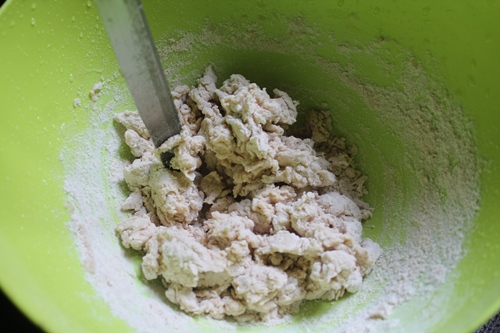
5)Once the flour is mixed with the water. You can start kneading the dough. If you feel the dough is sticky add more flour. if it is too dry, then sprinkle some water.
You have to keep kneading the dough till it is soft and smooth.
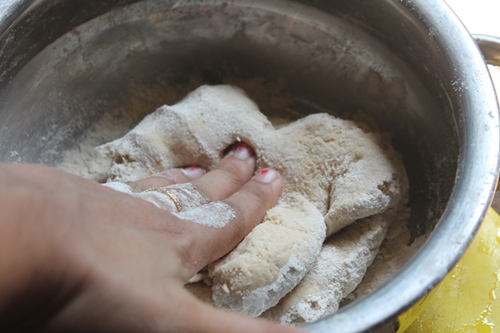
6)This process will take at least 3 to 5 minutes. The dough should be smooth and supple. The top shouldn't have any dry patches of flour. It has to be smooth.
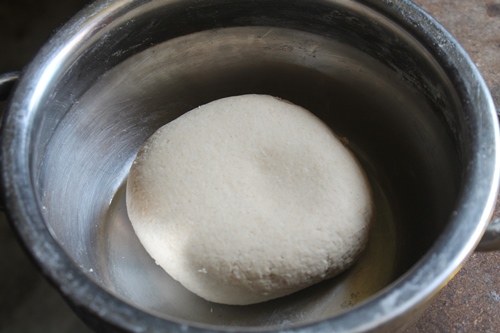
Resting the Dough
7)Once you finish kneading the dough, you have to allow the dough to rest for at least 30 minutes. The more time you rest the dough the softer it becomes.
Drizzle few drops oil over the top of the dough. This prevents a dry skin forming on top of the dough.
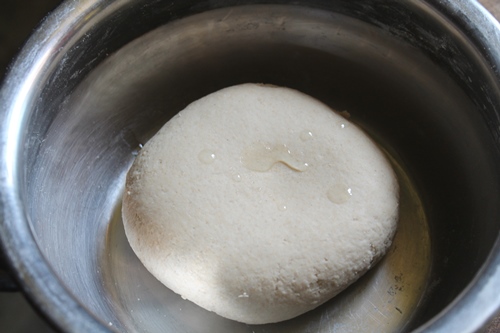
8)Spread the oil evenly over the dough.

9)Now cover the dough with a bowl or damp cloth and allow it to rest for 30 minutes.
Pro Tip: resting the dough will make the wheat flour absorb the water and also the gluten relaxes which makes the chapati softer.
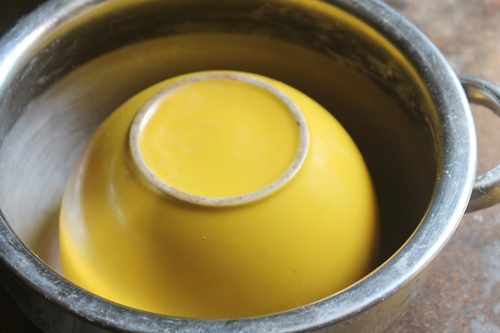
Dividing the Dough
10)Once the dough has rest. Divide it into equal portions. You can make the balls big or small as you like. Size of the chapati depends on the size of the dough ball.
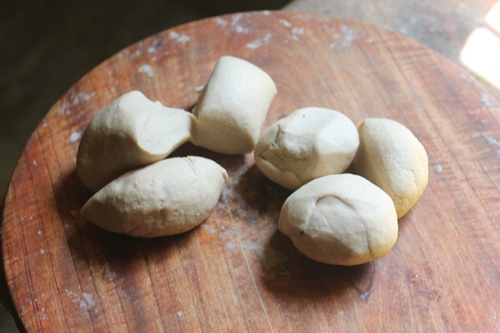
11)Shape each portions into a smooth ball like this.
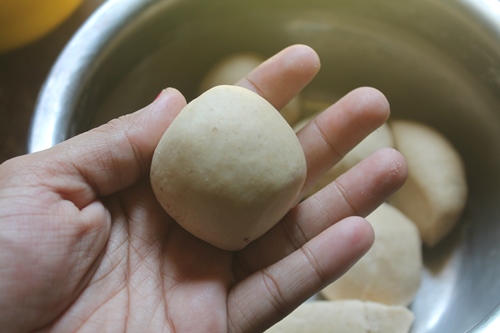
Rolling Out Chapati
12)Dust a rolling board with some wheat flour. Place the ball of dough in the centre. You can sprinkle more flour on top of the ball if it is sticky.
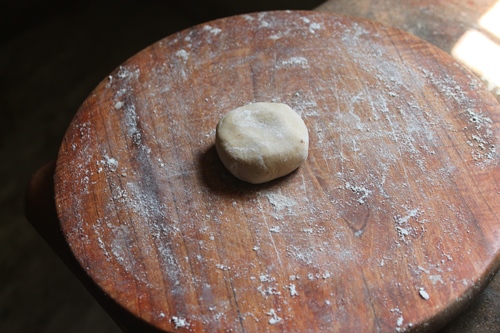
13)Roll the dough into even round chapati. Make sure you keep rotating as you roll so the chapati doesn't stick in the bottom. Sprinkle more wheat flour if needed.
Don't roll the chapati too thick or too thin.

Cooking Chapati
14)Heat a tawa. I used my hard anodised tawa. Once the tawa is hot, place the rolled chapati over the tawa. Cook on high heat for few seconds.
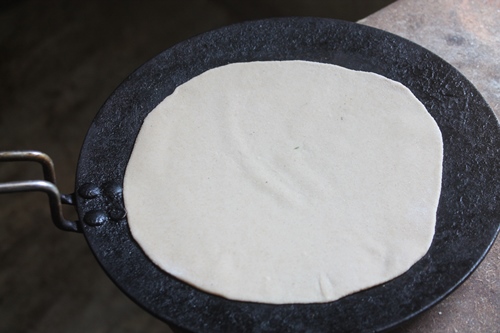
15)Once you see small bubbles on top of the chapati, and the chapati looks dry on top you are going to flip it over.

16)Flip the chapati carefully. You will see brown spots on the chapati like this. Continue cooking for few more seconds.
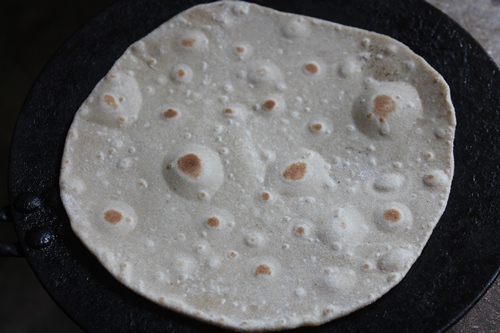
17) After few seconds, you will see more bubbles on top.
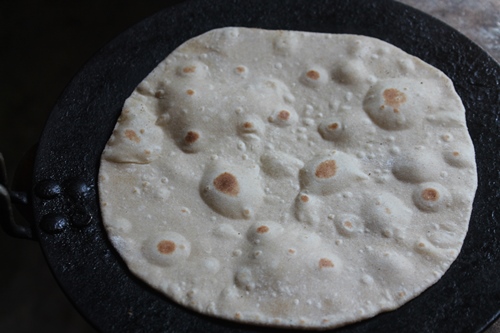
18)Flip the chapati over. The bottom will be cooked completely now.

19)Use a spatula to press gently on top of the chapati to make it blow like a balloon.

20)Perfectly cooked chapati is ready.
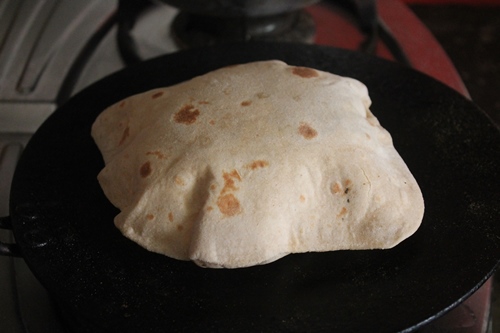
Storing Chapati
21)you can store the chapati in bamboo basket of in hot case. Storing it in basket like this will prevent the chapati from getting soggy.

22)Serve chapati with any of your favorite curries.
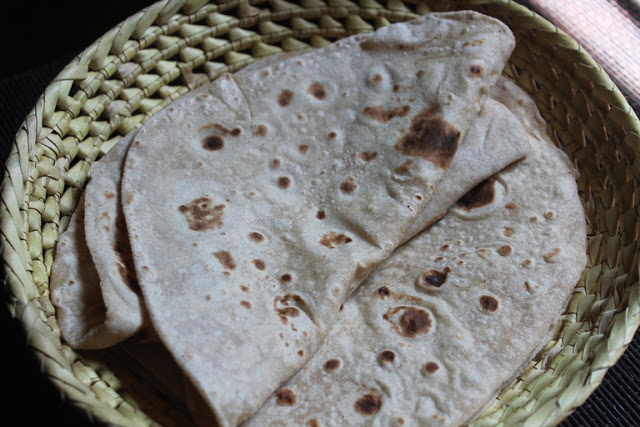
How to Make Chapati Dough in Stand Mixer
Making chapati dough by hand is quite easy as you keep on practicing. But it can be tricky for some people who don't have much experience in chapati making. Stand mixer comes in handy at those times. You can make chapati dough in half the time and the end product is so worth it. The dough turns out super soft which makes the process so easy.
After buying my very first stand mixer (my dream actually) I have been making chapati and bread dough in this. This has made my life so much easier. It is super easy to make as well. I actually have a recipe video on how to make chapati dough in stand mixer on my youtube. Here is the recipe for it.
Measurement for Chapati Dough in Stand Mixer
- 3 cups Wheat Flour
- 1.5 tsp Salt
- 1 cup Water (plus 2 to 3 tbsp if needed)
- 1 tbsp Oil
How to Make
1)Take wheat flour in your stand mixer bowl. Add in salt directly into it. Fix the stand mixer bowl in the machine and lock it. Place the dough hook on the machine.

2)Mix the wheat flour with the salt for few seconds. Now slowly add in 1 cup of water slowly into the wheat flour and let it mix. Sometimes the dough will be too dry, at this point you can add little extra water.
Once the dough starts to come together, add in 1 tbsp of ghee or oil and knead the dough for at least 3 to 5 minutes.

3)The dough should be soft, supple like this. Cover the dough and allow it to rest for 30 minutes before dividing into equal portions and rolling out chapati.

4)Cook chapati like mentioned above and enjoy.
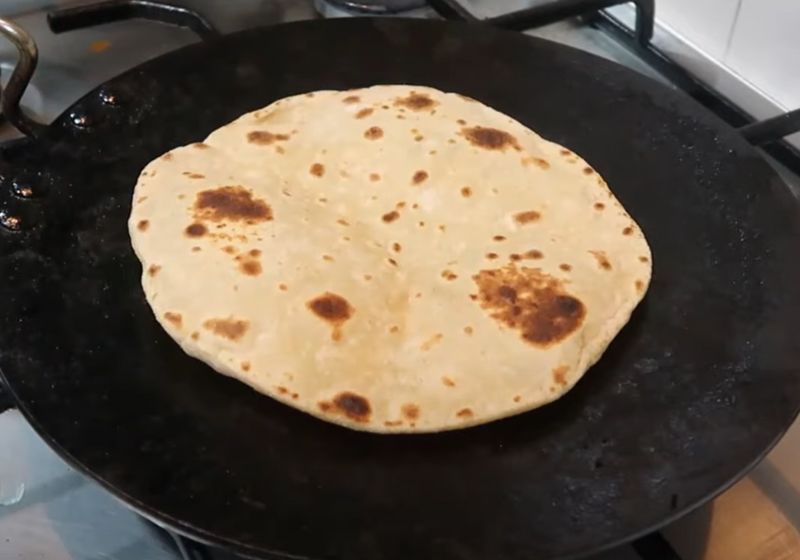
Hacks for Making Soft Chapati
Using Banana & Milk for Soft Chapati
This hack for making soft chapati really works. If you add banana and milk while making chapati dough, the chapati turns out soft and stays soft for a long time. I make this kind of chapati for my little one, she just love chapati.
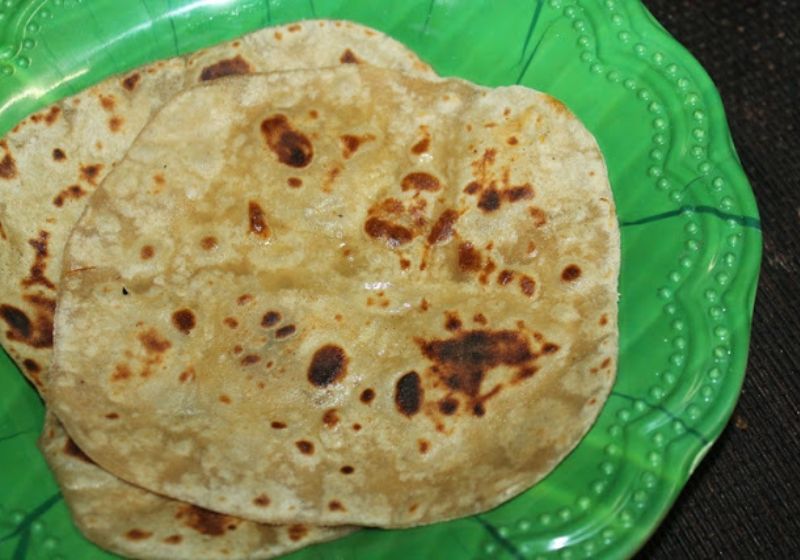
Ingredients for Banana Chapati
- Ripe Banana - 1 large peeled and mashed
- Wheat Flour - 3 cups or as needed
- Milk - ½ cup
- Salt - 1 tsp
- Ghee - 1 to 2 tblspn + more as needed
How to Make it
Take banana in a bowl and mash it well. Add in milk, salt, ghee and mix well. Add in wheat flour and mix well. Now knead this to a soft dough, add more flour as needed. Now cover it and let it sit for 30 mins. After 30 minutes, knead it well once again.

2) Divide the dough into equal portions. take a ball and dust it with flour and roll it into chapati.. Place it on hot tawa and cook for few seconds. Flip over, spread ghee and flip over. Cook till cooked on both sides. Now remove and store in hot case. Serve.
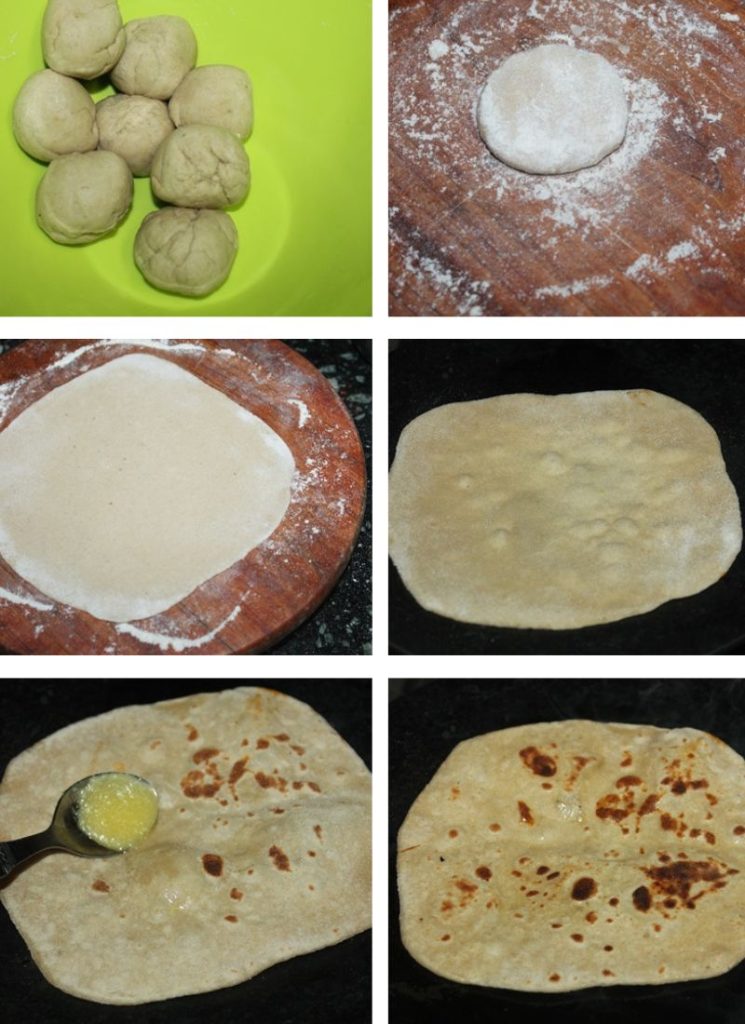
Using Curd (Yogurt) in Chapati Dough
One of my North Indian neighbour taught me this recipe. The chapati made this way is so soft, flavourful and tasty. You don't need any side dish for this, just have it with some pickle or curd and it is good enough. This is a simple and soft chapati made using yogurt.
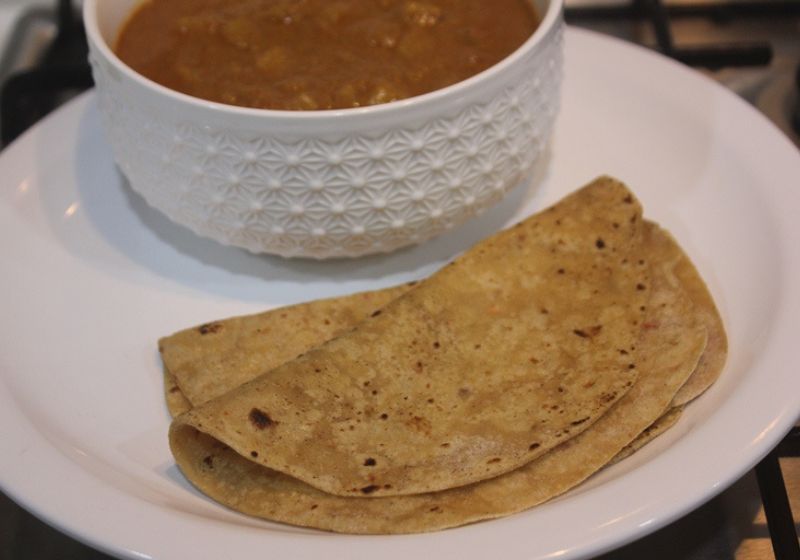
Ingredients for Chapati with Curd
- Yogurt / Curd - ½ cup
- Roasted Cumin Powder - 2 tsp
- Red Chilli Flakes - 1 tsp
- Salt to taste
- Wheat Flour - 2 cups or more
- Water as needed
How to Make
1)Take curd, and all ingredients in a bowl except flour and oil and mix well. Add wheat flour and knead to a soft dough. Cover and let it rest for 30 mins. Take small portion and roll it into chapati. Cook chapati till golden on both sides. apply oil around the sides and cook. Serve.
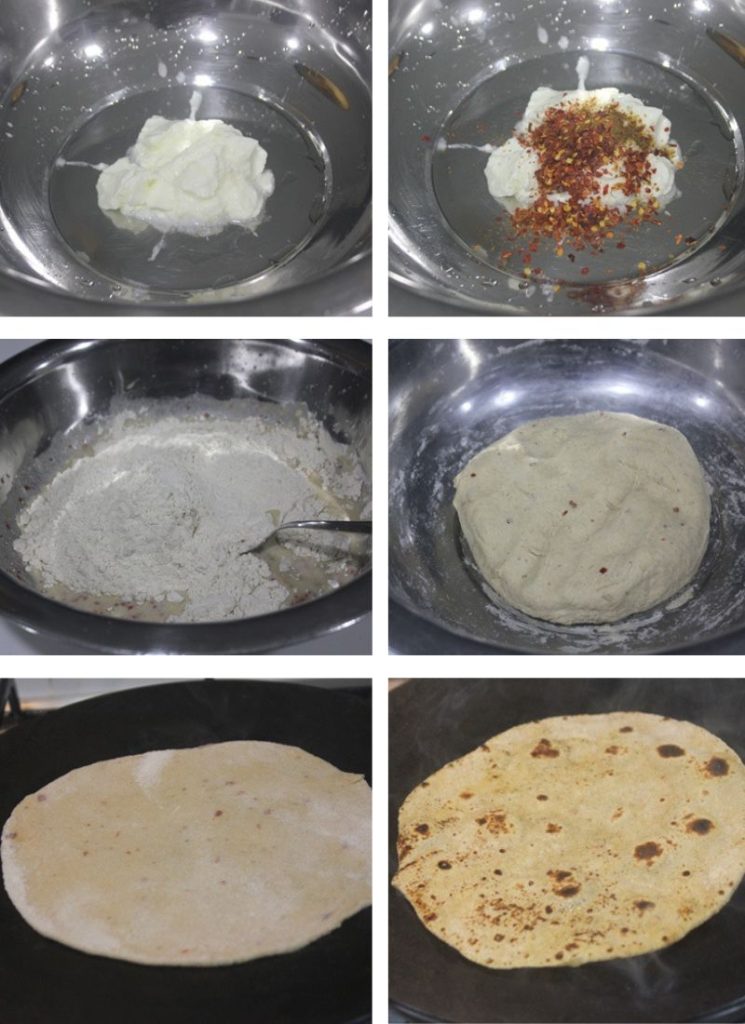
Variations
You can make chapati | rotis thousand different ways. You can flavour them with spices, herbs, vegetables & fruits. I am sharing few ideas for making different flavoured chapati or paratha.
Masala Chapati- you can add wide variety of spice powder to make this kara chapati.
Ajwain Paratha - ajwain also known as carom seeds adds a smoky aroma to chapati.
Spinach Chapati - add spinach puree to wheat flour when making dough to make this green flatbread.
Chayote Flatbread - chow chow, chayote is added in wheat flour to make this wholesome chow chow chapati.
Ragi Masala Chapati- healthy way to include ragi (finger millet) in your diet.
Oats Chapati - how about adding some oat flour to wheat dough and making this fibre rich oats chapati.
Coriander Flatbread- add a good amount of chopped coriander leaves when kneading dough and you have a delicious coriander flavoured flatbread

Expert Tips
Here are my tips for getting soft chapati all the time. Few tips & techniques for soft chapatis,
- Add flour slowly to the water and knead it to a soft dough.
- Knead the dough for at least 3 to 5 mins.
- Rest the dough for minimum 15 mins and maximum 1 hour.
- Roll the chapatis little thin, but not too thin or too thick.
- Heat the tawa really well before putting the chapati in.
- Flip it just twice, don't keep on flipping over.
- Once the chapati is cooked, remove it to a plate, spread some ghee or oil over and store in a hot case.
Side Dishes for Chapati
📖 Recipe Card
Chapati Recipe | How to Make Soft Chapati | Indian Flatbread
Equipment
- Mixing Bowl or Parat
- Rolling Pin & Board or Chakla Belan
- Roti Tawa
Ingredients
- 3 cups Wheat Flour or as needed
- 1¼ cup Warm Water or more
- 1 tsp Salt
- 1 tbsp Oil + more as needed
Instructions
- Take water and salt in a bowl. Mix well. Add in wheat flour and mix well. Now knead this to a soft dough, add more flour as needed. Knead it for 3 to 5 mins. Drizzle top with oil and spread well. Now cover it and let it sit for 30 mins. After 30 minutes knead it well once again.
- Divide it to equal portions, take a ball and dust it with flour and roll it into little thin chapati.
- Put it on hot tawa and cook for few seconds. Flip over and cook for few sec, now flip over again and cook Press bubbles on top till puffs up.
- Now remove and store in hot case. You can drizzle the top with some ghee. Serve.
Video

Notes
- Add flour slowly to the water and knead it to a soft dough.
- Knead the dough for atleast 3 to 5 mins.
- Rest the dough for minimum 15 mins and maximum 1 hour.
- Roll the chapatis little thin, but not too thin or too thick.
- Heat the tawa really well before putting the chapati in.
- Flip it just twice, dont keep on flipping over.
- Once the chapati is cooked, remove it to a plate, spread some ghee or oil over and store in a hot case.
Nutrition
If you have any questions not covered in this post and if you need help, leave me a comment or mail me @[email protected] and I’ll help as soon as I can.
Follow me on Instagram, Facebook, Pinterest ,Youtube and Twitter for more Yummy Tummy inspiration.
IF YOU MAKE THIS RECIPE OR ANYTHING FROM YUMMY TUMMY, MAKE SURE TO POST IT AND TAG ME SO I CAN SEE ALL OF YOUR CREATIONS!! #YUMMYTUMMYAARTHI AND @YUMMYTUMMYAARTHI ON INSTAGRAM!




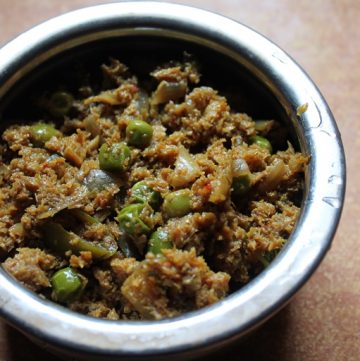

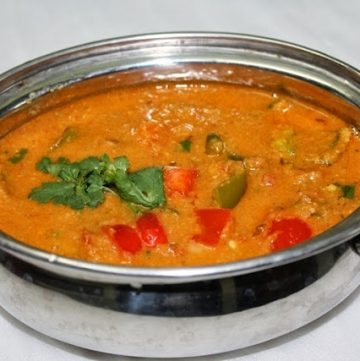
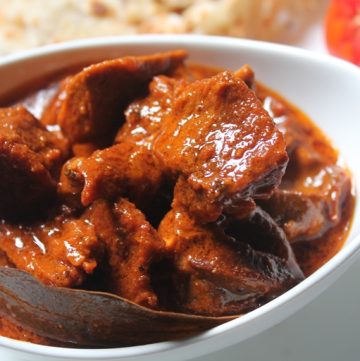
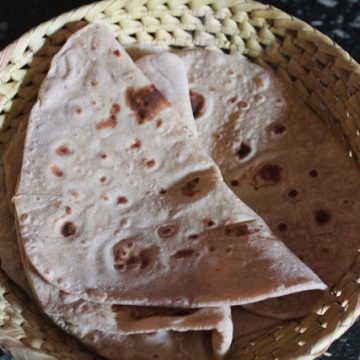



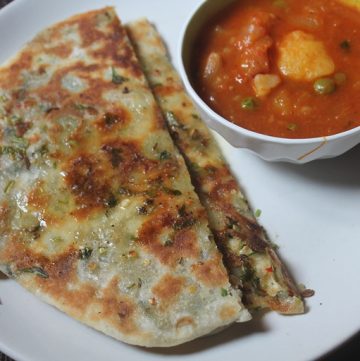
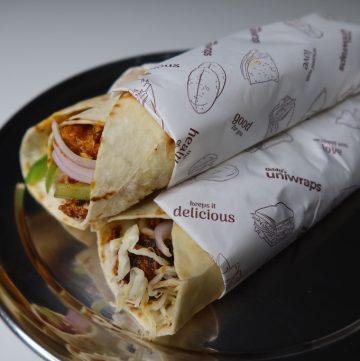
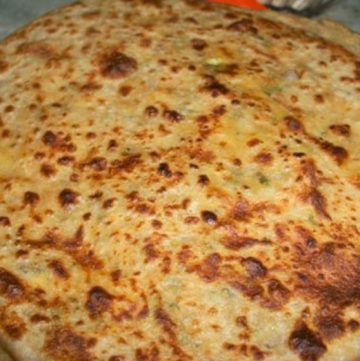
Unknown
Love all your recipies. Gonna try this chapati soon
Gowraj Here
step by step method with pics really helpful.great job.thank you so much.
Rathi
What temp we should cook this....in High heat or Medium?
Aarthi
cook in medium high heat
Unknown
Now that you say it, it makes sense. It's like adding acid to water in our school chemistry labs. Clever food chemistry! Kudos!
Manoj Kusshwaha
How to make chapati round i have tried so many times but every time it looks like map
Unknown
Looks simple. Tq.
Anonymous
Shd we add hot water or cold water
Anonymous
Hot or cold water??
Dilip Rajgariah
Which water is better for kneading
Hot or normal
Denzil de Sousa
Hi Aarthi,
I've been meaning to post a comment for quite some time now but thought I should make more attempts before I make a comment.
Am referring to your recipe for "soft chapatis". I have tried and tried and really tried it out but somehow it just doesn't work. The dough falls so much in love with the vessel (thought awww...cho chweet) that it just doesn,t want to leave it. So had to remove it forcibly but realised that it quickly falls in love with any and evrything that it comes in contact with (my hands topping the list of course). the granite worktop, crockery / cutlery,
In short I couldn't get past Step 2, despite following your instructions very very explicitly . (I even changed brands of flour)
So what's your secret? Am even more intrigued now than I was before. So, come on, can't wait to hear how you do it. (BTW... have tried the same method for the last 3 months...am hoping that there's something I must be doing wrong)
Margie Erdman
You've simplified a subject that has always confused me, thank you!
Lucrecia Berto
Big thanks and love! ❤️